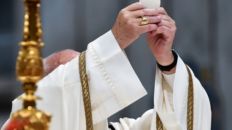The Story Behind Using A St. Joseph Statue To Sell Your House
We’d been in our new house for just a few weeks when my husband found a gallon-sized zippered bag buried in the backyard.
The previous owners had a young son, so we’d been finding all sorts of buried treasures in the flowerbeds and under the deck, but this was a decidedly different find: There was a little statue of a man holding a child in the bag. It looked like the kind of figure you might find in a nativity scene, and I guessed he was most likely a saint, as I had seen similar statues in a religious goods store.
Not being Catholic or particularly religious, I had no idea who he was — or why he might be buried in my backyard.

Turns out, it was a statue of St. Joseph (with, presumably, a young Jesus, since the Joseph we’re talking about here was that Joseph — you know, Mary’s husband?) and his purpose was to help the house sell faster.
In the Catholic tradition, St. Joseph is the patron saint of workers and fathers, among other things. The legend of St. Joseph’s real estate prowess has earned him everything from a Snopes entry to dozens of anecdotes across the internet.
As Snopes notes, no one knows exactly when the custom of using a St. Joseph statue to help sell a home became popular, but he seems to have reached widespread use in the U.S. around 1990, “with realtors buying plastic saints’ statues by the gross.”
Though the people we bought our house from didn’t follow the St. Joseph legend exactly (more on this below), we did make an offer on their house within a few weeks of it going on the market. Was it St. Joseph’s influence? We’ll never know, but they had put the house on the market previously with no luck.
Here’s how the process generally goes:
1. Bury St. Joseph in your yard.
How you bury him depends on which source you consult and your own preference, but the most frequently mentioned method is that he should be buried upside down in the front yard facing the house. This placement assures he will work hard to sell the right house. For condo dwellers and those who don’t have a yard, bury St. Joseph in a pot near the front door. You can wrap him in protective cloth or put him in a bag, as the previous owners of our home did, to keep him protected from the elements. (It also seems more respectful.)
And no, you don’t have to be Catholic or even a Christian to put your faith in St. Joseph. Author and homeowner Erica Orloff describes herself as “an atheist, or at least a very cynical agnostic,” but she grew up with the traditions of her grandparents’ Catholic faith.
“I have my grandparents’ crucifixes on my walls, and carry Mass cards and assorted Catholic items in my purse. So it felt like a natural thing to me, a cross between superstition and a talisman,” she told me.
She buried St. Joseph in the yard after her home languished on the market for eight months. The result? “It sold in an all-cash deal in under a week,” she said.





